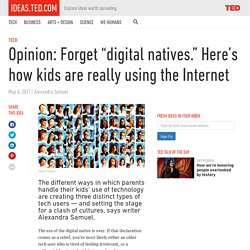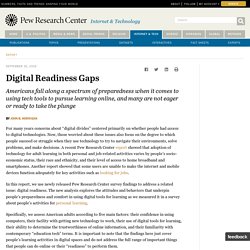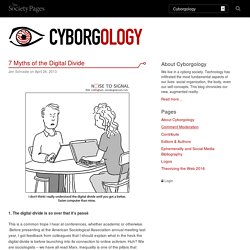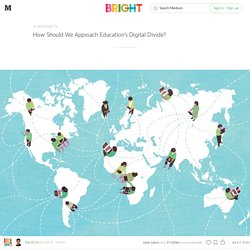

Forget digital natives. Here’s how kids are really using the Internet. Doug Chayka The era of the digital native is over.

If that declaration comes as a relief, you’re most likely either an older tech user who is tired of feeling irrelevant, or a millennial frustrated with being reduced to a headphone-wearing cliché. In 2001, education consultant Mark Prensky coined this term — along with calling the analog-raised generation “digital immigrants” — to alert teachers to the emerging wave of students who’d be arriving at schools with new ways of thinking and absorbing information after growing up with computers, videogames, digital music players, video cams, cell phones and other devices. The term was seized upon by news outlets, academics and businesses and ended up framing people’s understanding of the group born between the mid-1980s and mid-1990s. But it’s time to retire the idea that tech aptitude and social outlook can be boiled down to whether someone is a digital native or not. The impact of these differences will shape the Internet and the world. Is the digital divide entirely different from what we think it is?
For a while now, there’s been a great deal of concern over the digital divide—the gap between students who have easy access to technology and those who don’t.

Most debates center on choosing the best classroom hardware to bridge the gap: ‘Should we try to get a laptop on every desk? Tablets? Two-in-ones?’ However, the hardware debate obscures a deeper issue. It doesn’t matter what kind of technology a student uses, so much as what the student is encouraged to do with it. Digital Literacy and Learning in the United States. Americans fall along a spectrum of preparedness when it comes to using tech tools to pursue learning online, and many are not eager or ready to take the plunge For many years concerns about “digital divides” centered primarily on whether people had access to digital technologies.

Now, those worried about these issues also focus on the degree to which people succeed or struggle when they use technology to try to navigate their environments, solve problems, and make decisions. A recent Pew Research Center report showed that adoption of technology for adult learning in both personal and job-related activities varies by people’s socio-economic status, their race and ethnicity, and their level of access to home broadband and smartphones. Another report showed that some users are unable to make the internet and mobile devices function adequately for key activities such as looking for jobs.
Relatively Hesitant – 52% of adults in three distinct groups. 7 Myths of the Digital Divide - Cyborgology. 1.

The digital divide is so over that it’s passé This is a common trope I hear at conferences, whether academic or otherwise. Before presenting at the American Sociological Association annual meeting last year, I got feedback from colleagues that I should explain what in the heck the digital divide is before launching into its connection to online activism. Huh? We are sociologists – we have all read Marx.
But I’ve been told to always listen to my audience, who need a gentle reminder that digital inequality is alive and kickin.’ The digital divide is a way to talk about how some groups of people are not able to use the Internet, or other digital technologies, at the same rate as other groups. While race, ethnicity and age are strong factors in Internet use, my research has found that it is social class gaps that are most consistent over time. 2. How Should We Approach Education’s Digital Divide? — Bright.
Dear David, We are both working to solve the problem of equity in education.

I’ve spent my career in education, first as a teacher, and then as a lifelong advocate of improving learning opportunities for EVERYONE through technology. I am sure you see — as I do — pockets of excellence in education. You know, those places where kids are designing, making, composing, filming, animating, publishing, talking with each other. Students that are presented with complex challenges, like water availability and food security, and work to figure them out. But there are also too many places where that is not happening. I have tried to understand how technology can best “power up” the opportunity for these students to actively learn. How Should We Approach Education’s Digital Divide? — Bright. Dear Karen, We’re definitely in agreement on the premise.

The Digital Divide gets a lot of attention today. Many kids today do lack basic access to technology. As you point out, addressing this issue is a crucial first step. Stopgap solutions can help, while governments and schools work toward long-term solutions. But just giving children (or teachers) devices isn’t enough. I agree that beyond the Digital Divide, we need to solve the Digital Learning Gap.
Professional development for instructors is key. There are many teachers who embrace technology with open arms. A big part of the burden lies with education technology providers, too. “EdTech” companies should partner with teachers from the start. Tech shouldn’t be a chore; it shouldn’t be something that teachers or schools feel like they “have” to use.